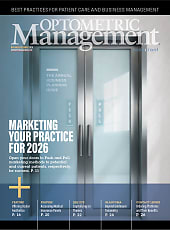Oxygen delivery and tear exchange are critical for maintaining corneal health during scleral lens wear. Fenestrations and back surface channels have been used since the 1940s in multiple types of contact lenses, including scleral lenses, to augment corneal oxygen transmission, aid in the removal of carbon dioxide from the post-lens tear layer, reduce corneal edema, and limit post-lens tear stagnation.1
When scleral lenses seal tightly and create suction on the eye, some manufacturers incorporate channels into the lens design to enhance tear exchange. These channels are milled into the back surface of the lens and may appear as distinct tunnels upon inspection. In some cases, the channel edges can be sharp and require post-manufacturing polishing.
Fenestrations serve to reduce lens suction and increase corneal oxygenation. These are sometimes referred to as “air-ventilated” designs.2 While these holes often create a bubble, adjustments can minimize bubble size or, in some cases, eliminate it by allowing tear exchange with minimal air intrusion. The number and placement of fenestrations vary, but are positioned peripherally, either in the optic periphery or mid-peripheral zone, to avoid the visual axis. A circumferential channel may also be incorporated to promote bubble mobility while preventing it from encroaching on the optic zone and disrupting vision. Bubble movement is important to prevent localized corneal desiccation underneath a stationary bubble.2
A review by Fisher and colleagues evaluated the use of contact lens fenestrations and channels in clinical and laboratory settings, evaluating their impact on tear exchange and corneal edema.1 Findings suggest that the evidence for the efficacy of fenestrations and channels is mixed.
While advancements in scleral lens designs have improved clinical performance, complications from corneal hypoxia still occur, particularly in individuals who have endothelial abnormalities. Fenestrated scleral lenses may help address hypoxia-related challenges and can also provide benefits in managing handling difficulties, midday fogging, lens suction, lens instability, conjunctival compression, and alteration of intraocular pressure.
References
1. Fisher D, Collins MJ, Vincent SJ. Contact lens fenestrations and channels in relation to tear exchange and corneal oedema. Clin Exp Optom. 2025 Jul;108(5):530-543. doi: 10.1080/08164622.2024.2426823
2. Johns L, Barnett M. Scleral Lens Anatomy. In Barnett M, Johns L, eds. Ophthalmology Current and Future Developments (Volume 4). Contemporary Scleral Lenses: Theory and Application. 2017, Bentham eBooks imprint.
3. Fadel D, Ezekiel DF. Fenestrated Scleral Lenses: Back to the Origins? Review of Their Benefits and Fitting Techniques. Optom Vis Sci. 2020 Sep;97(9):807-820. doi: 10.1097/OPX.0000000000001562
This editorial content was supported via unrestricted sponsorship.




